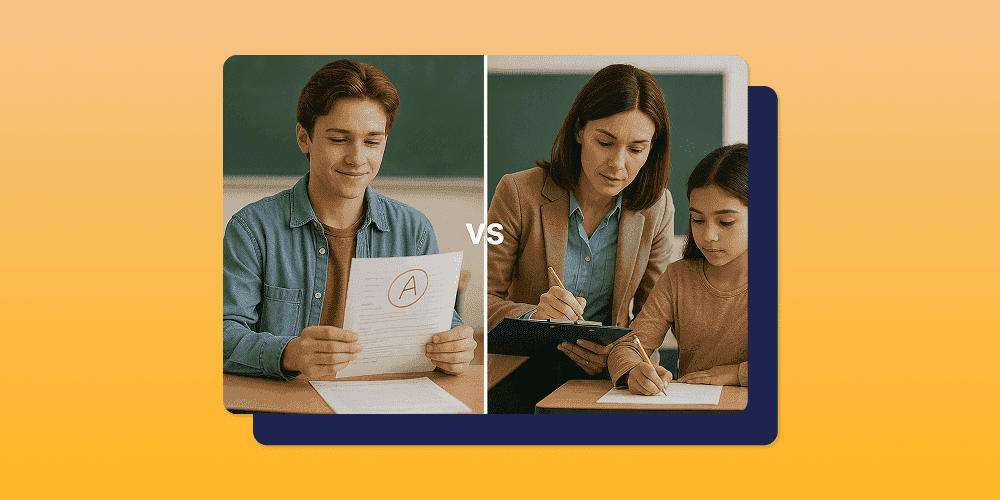
American summer tour! Wooclap will be at InstructureCon 2025
Come say hi at booth 41 from July 22nd to July 24th in Spokane, Washington
5 Different Teaching Styles: pros and cons
03.01.2025 • 4 minutes

There’s no such thing as a standard teacher, and the same applies to teaching styles. Although the love of sharing knowledge is a common trait to all teachers, specific situations or audiences require trainers to adapt to each of them.
A high school teacher will have to face a class of teenagers whereas a professor will be facing young adults. The sensitivities, maturity and engagement (and therefore content, strategies, classroom activities) can vary from one audience to another.
Given this context, choosing one’s teaching style or method isn’t always easy. In order to help you find the teaching style that suits you and your students best, Wooclap has prepared a comprehensive guide of the 5 different teaching styles, their pros and cons, and the situations in which you might want to use each approach.
A closer look at the 5 teaching styles
Here is a comparison chart of the 5 different teaching styles to give you a comprehensive overview and help you choose the right and most effective strategies to foster student engagement!
| Description | Situation | Pros | Cons | |
Direct | In this approach, the teacher plays a central role, by directing and teaching in explicit ways. | -Face-to-face; -Group work. | -Students are guided through straightforward instructions; -The teacher is highly available. | -Less autonomy for the students; -Rigid learning method. |
Indirect | The student is active in the learning process. | -Face-to-face; -Group work. | -It develops critical thinking skills within the classroom; -Content and concepts are more easily assimilated. | -Students sometimes struggle with understanding concepts (especially if the subject is complex) and the thought process; -Possible errors in judgement. |
| Description | Situation | Pros | Cons | |
Interactive | This approach encourages student-teacher interaction. | -Face-to-face, online or hybrid; -Group work. | -Flexible and adaptable teaching; -It encourages practice and engagement; -Higher student motivation. | -Students might struggle with speaking in public (with both the educators and the classroom); -Lack of digital resources. |
Experimental | This approach encourages action and thinking. | -Face-to-face, online or hybrid; -Group work. | - Focused on experience; - Effective when it comes to developing critical sense and hypothesis-making skills. | -Experimental teaching requires more time; -The activities must be adapted to the public, other than the subject. |
| Description | Situation | Cons | ||
Independent study | This approach encourages students to take initiative and reinforces self-confidence. | -Distance-learning; -Face-to-face. | Pros -Reinforces self-confidence; -Boosts engagement. |
The Direct Teaching Style
In the direct teaching style, the teacher plays a central role. They set the pace of each teaching session through exercises and structured lessons. The teacher is a guide throughout the sequence and answers students’ questions if needed.
The direct style breaks lessons into 6 steps:
- Introduction;
- Presentation of a new concept or subject;
- Guided practice;
- Correction;
- Individual application;
- Assessment.
Traditional teaching methods offer students a sense of structure and clarity, with the teacher serving as a central guide throughout the learning process. This framework can be reassuring, especially for those who thrive on routine and direct support. However, as Tornike Asatiani, Founder of Edumentors online tutoring services, points out, this approach may also limit students' autonomy and opportunities for exploration:
“Traditional teaching methods offer structure and clear guidance, which can be reassuring for students who thrive on routine. However, by placing the teacher at the center of the learning process, this model can limit students’ ability to take initiative and explore topics independently. While effective for building foundational knowledge, it may fall short in encouraging the critical thinking and creativity essential for success in today’s fast-changing world.”
The Indirect Teaching Style
In the indirect teaching style, students take the driver's seat.
This teaching style is used to develop critical thinking and decision-making skills. Its ultimate goal is for students to find the means to solve problems and validate hypotheses and scenarios.
Although this teaching style is known to make students autonomous, it also carries a higher risk of making errors in judgement or developing wrong thought processes.
The Interactive Teaching Style
The interactive teaching style was first presented in the 80s, in the University of Waikato in New Zealand.
Among the different teaching styles, it is the most collaborative approach –and it places the teacher at the same level as students. The goal is to learn and understand concepts in order to assimilate knowledge in the long term.
Many different exercises can be used in this type of teaching, such as brainstorming, word association games, or Q&A exercises.
Here are a few of its multiple advantages:
- Progress can be easily measured;
- Teaching sessions become more collaborative both in the classroom and online;
- Flexibility in terms of teaching methods and resources available;
- The right combination of theory and practice;
- Effective approach to encourage higher student motivation.
The interactive teaching style’s major inconvenience is that certain students’ shyness may keep them from taking part in the activities (therefore this approach could be more or less effective based on the learners). The lack of digital resources to provide a clear framework for certain workshops and activities can also be an obstacle.
The Experimental Teaching Style
The experimental reaching style is based on Kolb’s Experiential Learning Theory (1984) and focuses on practice in the different teaching methods used.
This style encourages the following:
- Concrete experience;
- Reflective observation;
- Abstract Conceptualization;
- Hypothesis-making.
This teaching style fosters action and reflection among students while valuing divergent opinions and processes of thinking.
However, the experimental teaching style requires important time and effort. Also, learning activities should be adapted to the public and be perceived as attractive, to keep students focused and motivated.
The Independent Study Teaching Style
The independent study teaching style encourages taking personal initiative to develop decision-making skills, judgement abilities and self-confidence. Learners can thus gather knowledge and progress at their own pace.
Student engagement, autonomy and the ability to solve problems are reinforced.
Distance-learning courses are an example of independent study learning.
For students who struggle with organisation (finding their marks, staying focused, managing time and being productive), this type of teaching style can be challenging.
What is the most efficient teaching style nowadays?
In terms of teaching, the key is to adapt your teaching style to your audience (whether it is a classroom of teenagers, a group of professionals, etc.), by proposing different approaches, methods, activities and resources that take into account not only the pedagogical goals and challenges, but also your students’ level.
Choosing the right teaching style among the ones available allows boosting student motivation and engagement.
How to adapt your teaching style
Once you’ve decided which learning style and teaching strategies you wish to implement (and suits you the best), you should get hold of the right tools.
Discover Wooclap, a tool that helps you build custom teaching sequences through diverse and engaging resources such as quiz tests, brainstorming tools or polls, among others.
Writer

The Wooclap team
Make learning awesome & effective
A monthly summary of our product updates and our latest published content, directly in your inbox.



